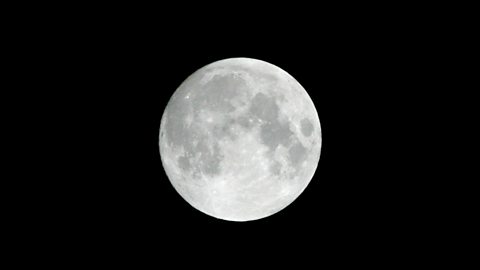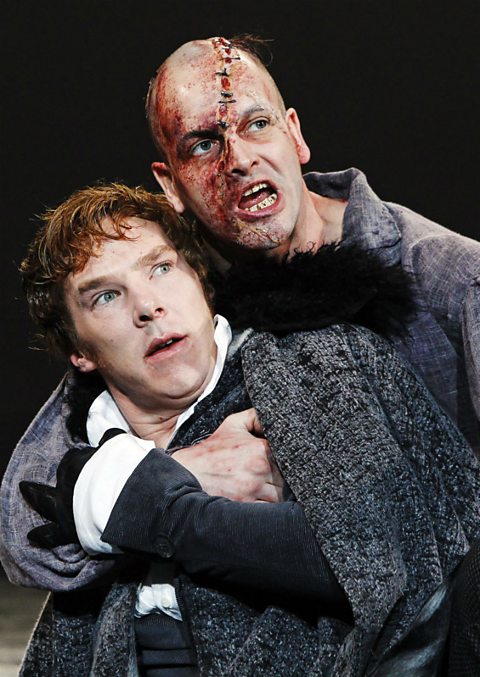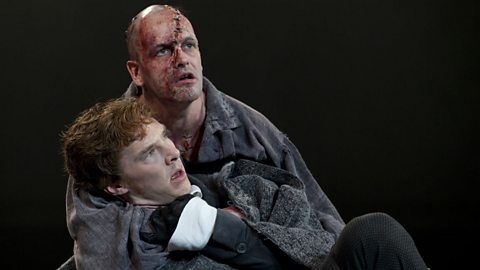Use of language in Frankenstein
Language refers to the choices of style and vocabulary made by the author. When analysing the language Mary Shelley uses you should think about:
- What? The author's choice of specific words and literary deviceAny method an author uses to add meaning or interest to a text, such as metaphors, similes or alliteration..
- Where/who/how? The way in which the author uses them.
- Why? The effect on the reader.
Frankenstein was Mary Shelley's first novel and also her most famous. Despite being only 18 when she first came up with the story (it was published just two years later) she demonstrates a sophisticated use of language of a writer with many more years of experience.
Evidence and explanation of the language used
Here are some examples of language choices which Shelley makes. Two main ones are motifA recurring element or symbol in a text (or work of art), the repetition of which contributes to establishing a theme. and allusionA quick reference - often to an image, character or place - from a work of literature or music or mythology..
1. Motifs
A motif is a recurring item which takes on a symbolicThe use of images or things (usually physical, like a flag) that stand for or represent something else, usually something abstract like a nation. meaning, contributing to the themes of the text. In Frankenstein, three notable motifs are: the moon, the doppelganger (lookalike) and light and fire.
The moon

One of the first experiences the Monster has after it is created is of seeing the moon in the sky: 'soon a gentle light stole over the heavens and gave me a sensation of pleasure. I started up and beheld a radiant form rise from among the trees. I gazed with a kind of wonder. It moved slowly, but it enlightened my path'. Although it has no name for what it has seen, the moon fills the Monster with a sense of pleasure and wonder and acts as a guiding light in the absence of any human contact.
Thus a link between the Monster and the moon is created.
Later in the novel, the moon tends to appear just before the Monster does - for instance it is shining on the night of Elizabeth's murder. As the reader knows the Monster and the moon are connected, the latter's appearance gives the reader a sense of anticipation about what is going to happen next, which builds tension in the narrative.
The doppleganger

Doppelganger is a German expression meaning a lookalike (literally "double walker"). In literature a doppleganger often takes the form of an evil twin or the wicked side of someone with a split personality (the most famous example is perhaps Mr Hyde in Robert Louis Stevenson's Dr Jekyll and Mr Hyde).
In Frankenstein, it is possible to see the Monster as the dark side of Victor's nature. As the young scientist pursues his studies, he divides his desire for knowledge from his feelings and responsibilities towards other people and therefore becomes more monstrous. The Monster for quite some time is rational and uses education to better itself - just like Victor. So the two characters become increasingly alike and Shelley emphasises this by making them similar in many ways.
Both Victor and the Monster are:
- outsiders who are isolated from society
- passionate and driven by ambition
- intellectually gifted
- able to use language to persuade and control each other
- driven by thoughts of justice and revenge
- monstrous - one because of physical appearance and one because of the actions he takes
Walton is sometimes regarded as another doppelganger of Victor's as they share similar traits and attitudes - such as ambition and a desire for discovery.
Light and fire
Many of the key events in Frankenstein take place at night or in dark and gloomy circumstances. Its opposite, light, is used to show the power of knowledge and discovery. Victor, for instance, thinks that by creating life he will 'pour a torrent of light into our dark world' and Walton talks of 'the eternal light' of the Arctic. However, while light can be a source of comfort, too much of it can be blinding and dangerous and it is this that the two men fail to recognise.
Like light, fire also both comforts and supports at the same time as being potentially dangerous. When the Monster first sees a flame it is 'overcome with delight at the warmth I experienced from it'. However he gets too close and discovers that it also has the power to harm: 'In my joy I thrust my hand into the live embers, but quickly drew it out again with a cry of pain. How strange, I thought, that the same cause should produce such opposite effects!' At the end of the novel, the Monster hints that he will end his life by committing suicide on a pyre (a funeral bonfire).
Light and fire are, significantly, brought together in the electric force that gives the Monster life.
Why does Mary Shelley use motifs?
Motifs give a sense of structure and order to a text and through their repetition help to develop and emphasise the important themes in a piece of writing. They also help to bring different elements of the story together, giving the reader a more satisfying experience.
2. Allusions
At the time of writing Frankenstein, it was common practice for authors to make references to other pieces of literature which they assumed their readers would have come across. The three major texts which Mary Shelley alludes to are the myth of Prometheus and two long poems: Paradise Lost and The Rime of the Ancient Mariner.
Prometheus

The full title of the novel is Frankenstein or The Modern Prometheus. In the ancient myth, Prometheus creates man from clay then steals fire from the Gods so that his creation can be more godlike. Victor Frankenstein, in a similar way, trespasses on what should be God's role when he created the Monster. Prometheus was continuously punished for his actions in the same way that both Victor and the Monster live lives of torment. Mary Shelley’s good friend Lord Byron published a poem called Prometheus shortly before she began work on her story and her husband Percy Bysshe Shelley later wrote a poem called Prometheus Unbound.
Paradise Lost
John Milton's epic poem Paradise Lost, written in 1667, is based on the Biblical story in which God creates Adam and then Eve. The reader is encouraged to link Victor to God, the Monster to Adam and the uncompleted female creature to Eve. The key figure in Paradise Lost, however, is Satan. He is an angel who rebels against God, is expelled from Heaven and brings sin and misery to the world. The Monster declares to Victor: 'I am thy creature; I ought to be thy Adam, but I am rather the fallen angel, whom they drivest from joy for no misdeed.' Victor also links himself to Satan when he says 'Like the archangel who aspired to omnipotence, I am chained in an eternal hell.' One of the books the Monster finds in the forest and which helps him to learn to read is a copy of Paradise Lost.
The Rime of the Ancient Mariner
This narrative poem was written by Samuel Taylor Coleridge and published in 1798. When Mary Shelley was a young girl she heard Coleridge reading his poem aloud. In the poem, the mariner tells of a sea voyage to the Antarctic where his ship becomes ice-bound. This directly parallels Walton's voyage to the Arctic and at one point Walton even directly refers to the poem. In Coleridge's tale, the mariner is guilty of shooting a harmless albatross. As a punishment, he is made to suffer continuously while all around him die. Victor, too, exists in a living hell as his family and friends are killed. The mariner eventually becomes an outcast having little contact with society; this directly parallels the experience of the Monster.
Why does Mary Shelley use allusions?
Shelley's allusions are able to provide a deeper level of meaning to her text as common themes are developed and highlighted. An allusion can connect a piece of writing to the context of the larger world and help the reader to understand the emotions and thoughts which the writer is trying to get across.